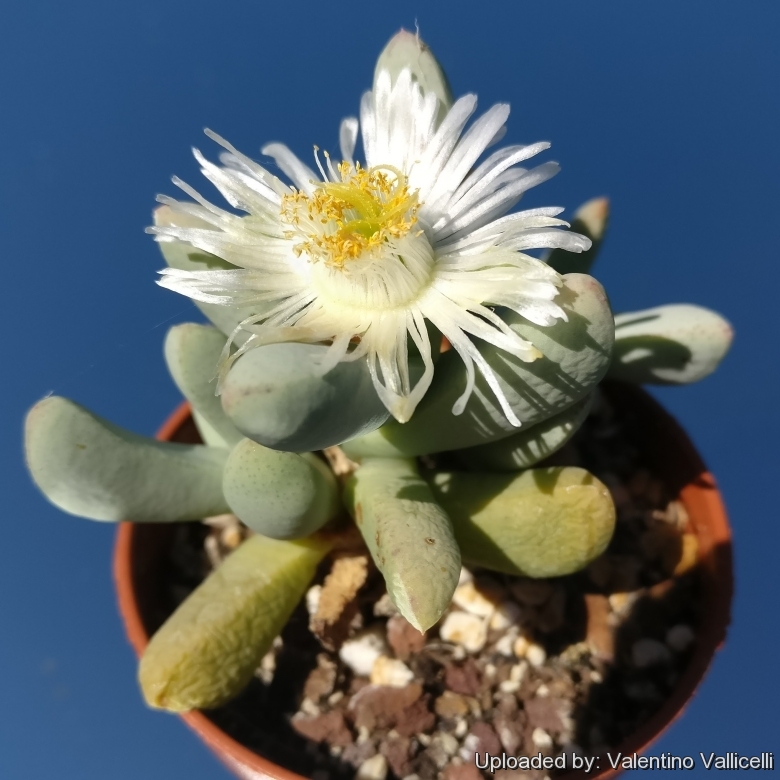Accepted Scientific Name: Juttadinteria deserticola (Marloth) Schwantes
Z. Sukkulentenk. ii. 183 (1926)

Juttadinteria decumbens Photo by: Valentino Vallicelli
North Sargdeckel, small form with white flowers.
Origin and Habitat: Juttadinteria decumbensSN|11595]]SN|11595]] grows in the arid region of Namaqualand (Namibia and South Africa)
Synonyms:
See all synonyms of Juttadinteria deserticola
back
Accepted name in llifle Database:Juttadinteria deserticola (Marloth) SchwantesZ. Sukkulentenk. ii. 183 (1926)Synonymy: 10
back
Description: Juttadinteria decumbensSN|11588]]SN|11595]], is a low growing succulent sub-shrub on woody roots, up to 5 cm high. It is generally included within (as a synonym of) Juttadinteria deserticolaSN|11595]]SN|11588]], suggesting that there is not really a fundamental difference between the two, and hard to name accurately without knowing where they come from. It has whitish, pretty closely set, boat-shaped leaves and white flowers that appear in the growing season in autumn and winter.
Derivation of specific name: The name decumbens, meaning "Lying or growing on the ground but with erect or rising tips ", refers to the low growing branches of this species.
Habit: Plant decumbent (stem creeps along ground) 5 cm high, branched. Branches to 25 cm long. 2-4 leaved. Older plants show the peculiarity that their growth mainly extends along the ground on both sides in one direction only, so that they produce clumps that are usually much longer (- 25 cm) than wide (-10 cm). The main horizontally extending roots show the same peculiarity, these are very long (to 50 cm). Secondary branches have l-2 pairs of leaves.
Leaves: Paired, fused at the base, thick, upper side flat or slightly convex, up to 1.5-3 cm long, 1-2 cm wide and 1-1.5 cm thick, grey-green to almost whitish, obtuse, keeled, glabrous.
Flower: Peduncle up to 2 cm long. Flowers up to 3 cm in diameter. Sepals 4. Petals white, up to 7 mm long. Stamens 7-20 mm long: Anthers yellowish. Stigmas 7-8, filiform, to 8 mm long.
Subspecies, varieties, forms and cultivars of plants belonging to the Juttadinteria deserticola group
 Juttadinteria decumbens Schick & Tischer: stem creeps along ground with erect tips up to 5 cm high, branched. Branches to 25 cm long. 2-4 leaved. Distribution: Namaqualand (Namibia and South Africa).
Juttadinteria decumbens Schick & Tischer: stem creeps along ground with erect tips up to 5 cm high, branched. Branches to 25 cm long. 2-4 leaved. Distribution: Namaqualand (Namibia and South Africa). Juttadinteria deserticola (Marloth) Schwantes: sub-shrub up to 20 cm tall. It has whitish, boat-shaped leaves and white flowers. Distribution: Western Namaqualand (South Africa) to Lüderitz-South in Namibia.
Juttadinteria deserticola (Marloth) Schwantes: sub-shrub up to 20 cm tall. It has whitish, boat-shaped leaves and white flowers. Distribution: Western Namaqualand (South Africa) to Lüderitz-South in Namibia.
Bibliography: Major references and further lectures
1) J. Neumann, “Kakteenkunde” 1933
Cultivation and Propagation: Juttadinteria is a "winter" grower which is most active from late winter until later spring and heading for summer dormancy, but in favourable growing conditions it keeps going over the summer too and don’t’ need particular care.
Soil: Requires good drainage as it it is prone to root rot.
Fertilization: they thrives in poor soils ans seems very sensitive to an excess of potassium.
Watering: Water minimally in summer, only when the plant starts shrivelling, water more abundantly when they are growing in the fall and spring. Requires little water otherwise its epidermis breaks (resulting in unsightly scars).
Light: Keep cool and shaded in summer, need full sun or light shade.
Hardiness: USDA zones 9A – 11. They prefer a very bright and arid situation and will take a light frost (Hardy to -5°C) if they are in dry soil.
Uses: Container, rock garden.
Propagation: Seeds, cuttings. It is difficult to root juttadinterias from cuttings and generally pointless as well, so quick are they from seed. They are easily propagated by seed.










